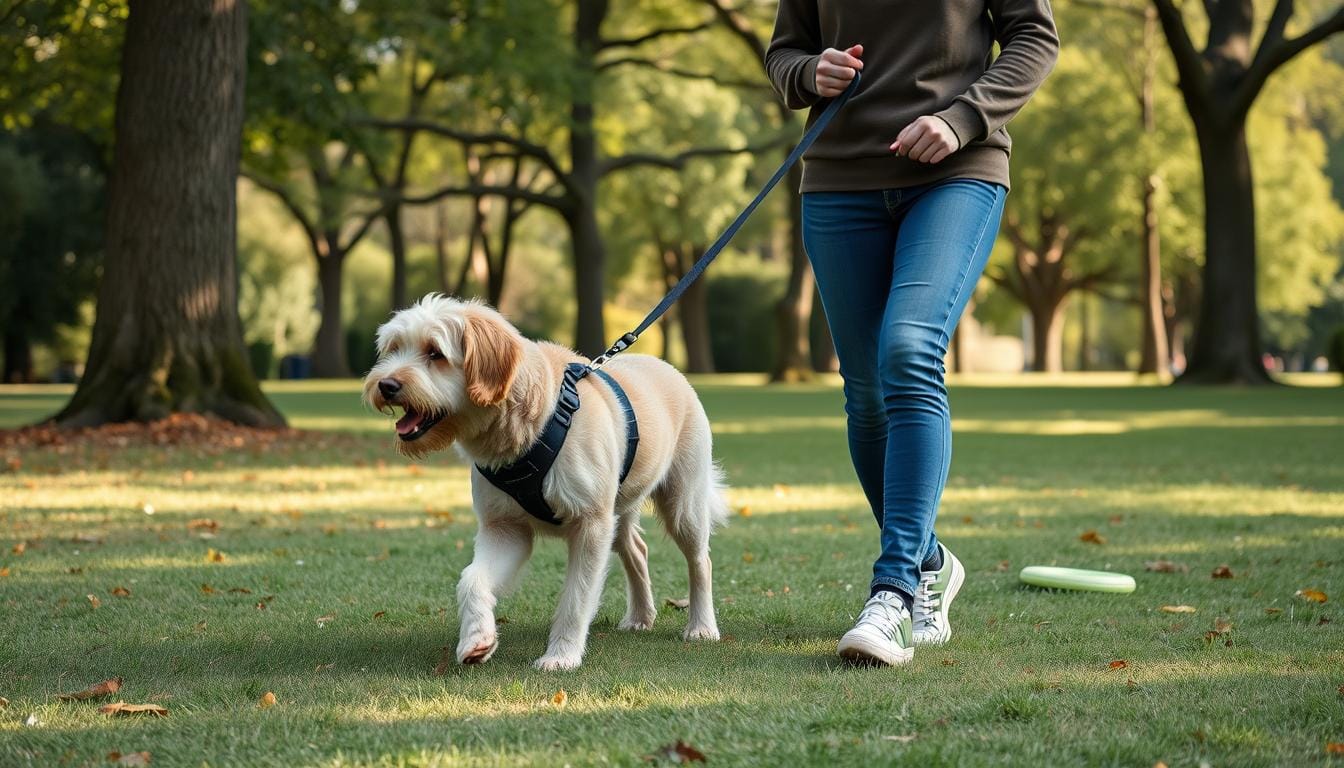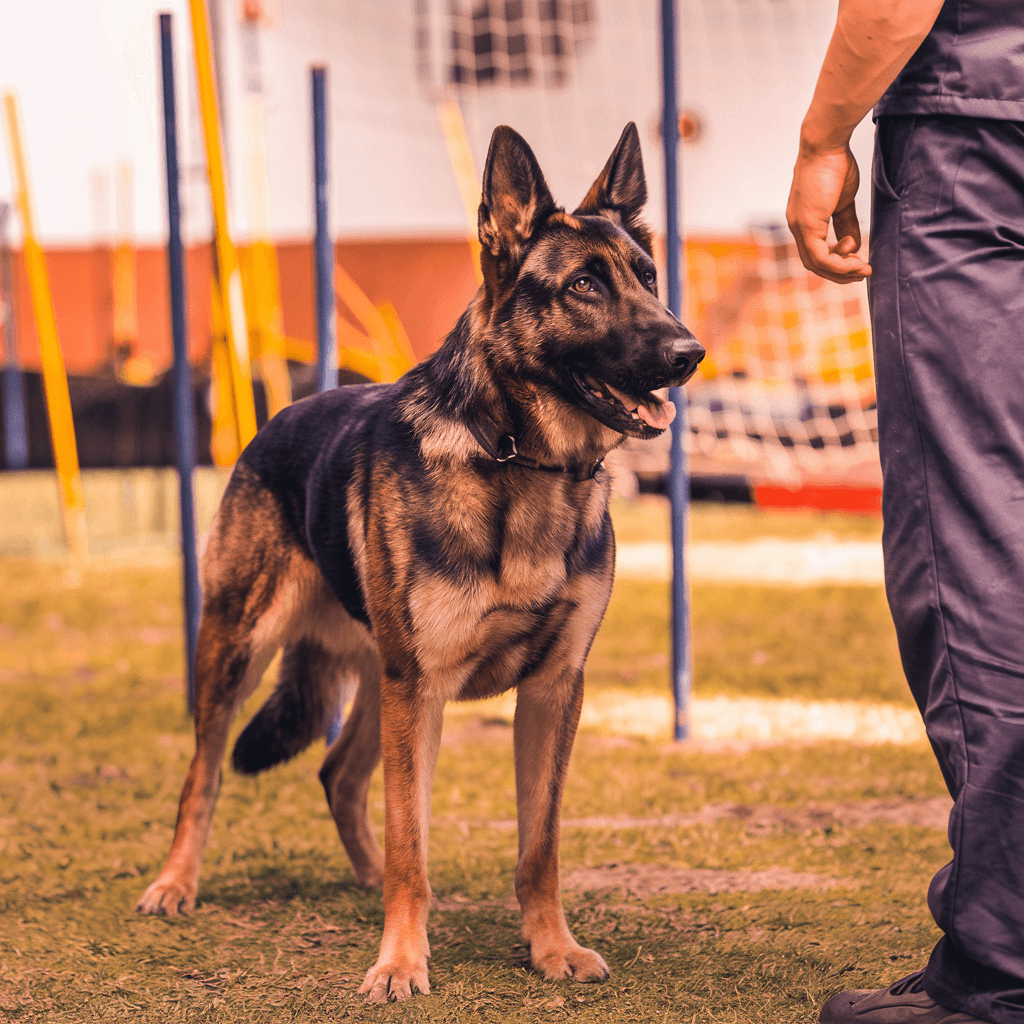Ever notice your dog tilt its head when you talk? We’ve all seen this charming dog behavior, but few of us know the science behind it. Dog communication involves more than just barks and tail wags. The dog head tilt is a fascinating aspect of canine behavior that’s caught the attention of researchers.
A groundbreaking study from Eötvös Loránd University in Hungary sheds light on why dogs tilt heads. Published in Animal Cognition in 2021, this research offers insights into this cute quirk. It turns out that head tilting might be linked to how dogs process information and recognize words.
The study found that “gifted” dogs – those able to remember at least ten toy names – tilted their heads 43% of the time when hearing a familiar toy’s name. In contrast, typical dogs only showed this behavior 2% of the time. This suggests a connection between head tilting and cognitive processing in our furry friends.
Key Takeaways
- Dog head tilting is linked to information processing and word recognition
- Gifted dogs tilt their heads more frequently than typical dogs
- Head tilting may be related to sound localization in dogs
- The behavior is consistent in individual dogs, often favoring one side
- Brain lateralization might play a role in head tilting direction
- More research is needed to fully understand this canine behavior
Understanding the Common Canine Head Tilt Behavior
Dog head cocking is a fascinating part of how dogs communicate. It’s a behavior where dogs tilt their heads to one side. This is a key part of their body language.
Definition of Head Tilting in Dogs
Head tilting in dogs means they cock their head to one side. They do this in response to sounds or when they’re with humans. It’s a part of their complex way of communicating without words.
Historical Observations and Cultural References
The painting “His Master’s Voice” made us all think about dogs tilting their heads. It showed our long interest in this behavior.
Frequency of Head Tilting Among Different Dog Breeds
A 2021 study in Animal Cognition looked into head tilting in dogs. It found that smart dogs tilted their heads 43% of the time when asked to find a toy. This was much more than the 2% for regular dogs.
All 40 dogs in the study tilted their heads during tests. This shows that head tilting is common among dogs. A border collie named Whisky was especially good, identifying 54 toys by name after three months.
This study opens up new ways to understand how dogs communicate and think. It encourages more research into why dogs tilt their heads in different situations.
The Neural Science Behind Dog Head Tilting
Dog head tilting is a fascinating behavior rooted in canine neurology. It shows how dogs process information and respond to stimuli through their head movements.
Research reveals that dogs process familiar human words on the right side of their brain. This brain lateralization is key in dog listening behavior. When a dog tilts its head, it’s not just being cute. It’s actively working to better understand and process the sounds it hears.

A study involving 40 dogs revealed some remarkable findings about dog attention signals:
- 43% of gifted word learner (GWL) dogs frequently tilted their heads
- Only 2% of typical dogs showed frequent head tilting
- The direction of head-tilt was highly consistent across monthly tests
- Inter-rater agreement for head-tilts was excellent, with Cronbach’s alpha exceeding 0.9
These results suggest a strong link between a dog’s cognitive abilities and its tendency to tilt its head. GWL dogs, especially Border Collies, showed this behavior much more often than typical dogs.
| Dog Type | Frequent Head Tilting | Statistical Significance |
|---|---|---|
| Gifted Word Learners | 43% | χ2 = 23.847, p |
| Typical Dogs | 2% | χ2 = 23.847, p |
This research opens up exciting avenues for understanding dog cognition and communication. Future studies combining behavioral and neural approaches could further unravel the mysteries of canine lateralization in processing human vocalizations.
Dog head tilt, dog behavior, dog communication, why dogs tilt heads
Dogs have a special way to talk to us, and tilting their heads is one of the cutest. This action means different things in dog language. Let’s dive into why dogs tilt their heads and what it tells us about them.
Processing Familiar Words and Sounds
When dogs hear words or sounds they know, they often tilt their heads. This is a sign they’re really listening. A study showed that smart dogs, who learn lots of toy names, tilt their heads a lot when asked to find a toy. But regular dogs only do this a little bit.
Social Interaction Signals
Head tilting is also a way for dogs to connect with us. It shows they’re interested and want to keep talking. Dogs that are good at socializing tilt their heads more when they’re with people. This is especially true for dogs with longer faces, like Greyhounds.
Emotional Responses During Head Tilting
A dog’s head tilt can show how they’re feeling. It’s a sign of curiosity or confusion. When we give them treats or walks, they might tilt their heads more. But, if a dog tilts their head all the time and it’s not because of us, it could mean they’re sick.
Knowing how dogs tilt their heads helps us talk better with them. It lets us understand what they need and how they feel.
Sound Localization and Auditory Processing
Dogs can locate and process sounds with amazing skill, often shown by their head tilts. This behavior, known as canine head tilt meaning, is key to how they understand their world.
How Dogs Use Head Tilts to Better Hear Sounds
Dogs have about 18 muscles in their ears, giving them control over their head movements. By tilting their heads, they can adjust their ear position to better hear sounds and tones. This skill is especially important for puppies, who tilt their heads more due to curiosity and learning.
Comparison with Other Animals’ Hearing Mechanisms
While dogs are great at sound localization, other animals have unique hearing abilities. For example, barn owls can turn their necks up to 270 degrees to find prey. Dogs, on the other hand, use subtle head tilts to improve their hearing.
It’s important to watch for persistent or uncontrolled head tilting in dogs. This could be a sign of confusion or health issues. If you notice this, it’s crucial to get your dog checked by a vet to rule out problems like hypothyroidism, which can cause neurological symptoms including head tilting.
| Animal | Hearing Mechanism | Head Movement Range |
|---|---|---|
| Dogs | Head tilting | Subtle adjustments |
| Barn Owls | Neck swiveling | Up to 270 degrees |
| Humans | Ear shape and position | Limited head turning |
The Role of Brain Lateralization in Head Tilting
Brain lateralization is crucial in dog behavior, especially in their adorable head tilts. Like humans, dogs favor one side of their body. This preference also applies to their mental processes.
A study in Animal Cognition found something interesting. Gifted dogs, who can learn toy names, tilt their heads 43% of the time when they hear a toy’s name. Typical dogs only tilt their heads about 2% of the time.
What’s even more fascinating is the direction of their head tilts. Gifted dogs always tilt their heads to the same side, no matter where their owner is. This shows that one side of their brain might be more active when they tilt their heads.
Science says dogs mainly process familiar human words on the right side of their brains. This might explain why some dogs tilt their heads more when listening to us. It’s like they’re tuning in to understand our words better.
This unique behavior isn’t just cute. It’s a peek into how dogs think and process information. By studying these patterns, we learn more about dog cognition. This strengthens the bond between humans and their canine friends.
Gifted Dogs and Their Head Tilting Patterns
Recent studies have shown a cool link between a dog’s learning skills and their head tilting. It seems some dogs are better at understanding us than others. This is based on interesting patterns in their head tilting.
Research Findings on Toy Name Recognition
Researchers looked at 40 videos of dogs fetching toys by name. The results were amazing. All 40 dogs tilted their heads when asked, but gifted dogs did it way more often.

Statistical Differences Between Gifted and Typical Dogs
The study found big differences in head tilting. Gifted dogs, who could find the right toys, tilted their heads 43% of the time. Typical dogs tilted their heads only 2% of the time. This shows a strong link between a dog’s learning skills and head tilting.
Learning Capabilities and Head Tilting Correlation
Our study found a clear link between a dog’s learning and head tilting. This behavior could be a sign of a dog’s curiosity and understanding. It might show how well a dog can learn and connect with us.
| Dog Type | Head Tilt Frequency | Object Name Recognition |
|---|---|---|
| Gifted Dogs | 43% | High |
| Typical Dogs | 2% | Low |
These discoveries could change how we see dog intelligence. They might help us find dogs with special learning skills. By noticing these cues, we can train dogs better and strengthen our bond with them.
Health-Related Aspects of Dog Head Tilting
Dog head tilting is often seen as cute, but it can also hint at health problems. Usually, it’s just a sign of their thinking or trying to hear better. Dogs tilt their heads to locate sounds, see better, or show they’re interested.
But, if your dog tilts its head a lot or in a weird way, it might be sick. Here are some important points about dog health and behavior:
- Occasional head tilting is normal and part of a dog’s way of talking
- Head tilting a lot without anything happening might mean there’s a problem inside
- Ear infections can cause head tilting, pain, and itching
- Vestibular system damage may lead to balance problems and head tilting
- Certain breeds, like French Bulldogs and poodle-crosses, are more prone to ear problems
If your dog tilts its head a lot or seems uncomfortable, see a vet. They can check if it’s just normal dog stuff or if there’s a health issue.
| Behavior | Possible Meaning | Potential Health Concern |
|---|---|---|
| Occasional head tilting | Curiosity, improved hearing | Usually none |
| Frequent head tilting | Confusion, hearing difficulty | Ear infection, vestibular issues |
| Head tilting with scratching | Discomfort | Ear mites, fleas |
| Head tilting with balance issues | Disorientation | Vestibular disease |
Knowing about dog head tilting and health can help you tell if it’s just normal or if your dog needs a vet visit. This way, you can get your dog the care they need on time.
Memory and Information Processing in Canines
Dogs have amazing brains, especially when it comes to understanding and remembering things. A recent study has uncovered how dogs remember and connect words, giving us a peek into their minds.
Mental Image Formation
Studies show dogs might create mental pictures, just like humans do when they remember things. This is especially true for “gifted word learner” dogs. They react differently to words, tilting their heads 43% of the time when given commands.
Word Association Patterns
The study, published in Animal Cognition, looked at 40 dogs from different breeds. Among them, seven border collies were found to be “gifted word learners.” They could recall toy names with rates between 57% and 91.5%.
This skill shows dogs have complex thinking abilities and pay close attention to what we say. Dogs always tilt their heads to the same side, no matter where their owner is. This might show they are actively thinking or remembering something linked to a word or sound.
These discoveries are exciting, but researchers say we need more studies. They want to understand what dog head tilts mean and how they relate to remembering and processing information.
Side Preference in Dog Head Tilting
Dogs show interesting patterns in how they tilt their heads. This gives us clues about their body language and thinking. Just like humans have a preferred hand, dogs often lean to one side when they tilt their heads.
Individual Consistency in Tilting Direction
Studies show dogs tend to tilt their heads in the same direction over time. In one study, dogs were tested every month. The results showed strong links between their head tilts:
- Experiment 1: r = 0.738
- Experiment 2: r = 0.841
- Experiment 3: r = 0.801
This shows each dog has a unique way their brain is organized. This affects how they tilt their heads.
Relationship to Other Lateralized Behaviors
Head tilting is linked to other behaviors in dogs. It’s like their paw preference or how they wag their tail. It shows how their brains work.
For example, smart dogs like Border Collies tilt their heads more when they learn new words. They tilt in 43% of trials, compared to 2% for regular dogs.
Knowing these patterns helps us understand dogs better. But, it’s important to remember. Head tilting is usually okay, but changes might mean they’re sick. If you notice something different, see a vet.
Human Interpretation of Dog Head Tilts
Seeing our furry friends tilt their heads always makes us smile. It makes us wonder what they’re thinking. Head tilts are a big part of how we see our dogs.
Studies say we think dogs tilt their heads when they’re curious or paying attention. This might have started as a way for dogs to show they’re interested. It’s also why many of us find it so charming.
Here are some interesting facts about why dogs tilt their heads:
- Younger dogs and puppies tilt their heads more as they explore their world.
- Some research suggests dogs tilt their heads to show empathy with humans.
- When dogs get positive feedback for tilting their heads, they might do it more often.
Knowing what head tilts mean can help in training. It shows dogs we value their attention and curiosity. But, if a dog tilts their head too much and seems uncomfortable, it could be a sign of health problems.
People love talking about dog head tilts online. Comments on articles about this topic keep coming, with lots of different views. This shows how much we care about understanding our dogs’ body language.
Conclusion
Our journey into dog head tilting has shown us how special this behavior is. It helps dogs in many ways, like hearing better and seeing clearer. This behavior is key to how dogs connect with us and their world.
Some dogs, especially smart ones, tilt their heads a lot when they remember things. This is different from other dogs. It shows how smart a dog is. Also, some dogs tilt their heads more than others because of their ears or face shape.
While head tilting is usually cute and safe, we should watch out for changes. If an older dog starts tilting a lot or if it’s new for them, it might mean they’re sick. We need to keep an eye on our pets and get help if they act differently.
In the end, dog head tilting lets us peek into their secret world. By understanding it, we can get closer to our dogs and make sure they’re happy and healthy. Studying dog communication helps us love and care for them even more.
















